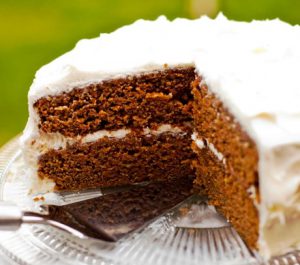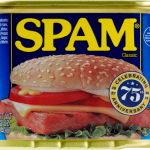An American Favorite – Carrot Cake

Several years ago, I did a stint as executive chef at a busy Texas hotel. Once or twice a month, usually after a busy Friday night, the kitchen staff and I would meet at Evelyn's Café for a late-night breakfast before going home. Evelyn was known miles around for was her delicious three- layer carrot cake—moist, not too sweet, filled with crushed pineapple and pecans. Fluffy cream cheese frosting was generously stuffed between each layer, and thick swirls of the stuff covered the cake's top and sides. And the wedge they gave you was big enough for two normal people to share, though I enjoyed each and every bite by myself, as carrot cake has always been one of my favorite cakes. Evelyn’s suddenly closed in February of 1989 and with its closing went the recipe for her signature cake.
Tomato Soup Cake
In spite of what some think, tomato soup cake was not the invention of Campbell Soup Company, but rather the creation of Depression-era housewives.
Recipes for tomato soup cake (sometimes called "Mystery Cake") first began making its appearance in community cookbooks during the 1920s and 1930s. Tomato soup concentrate was used in place of milk, butter and other dairy products to bring moisture and texture to this unusual dessert. After all, these products were hard to come by during the country's Great Depression.
Campbell's Tomato Soup was introduced to the American consumer in 1897, but the company didn't open their test kitchen until 1941. And though Campbell's was quick to develop their own version of tomato soup cake and use it to promote their soup, the first version was more like a British-style pudding than a cake. It was 1966 when Campbell's finally came out with the modern version of this once popular cake.
The first tomato soup cakes were most often simple single-layer or loaf cakes, usually served plain. Updated recipes called for two-layer cakes topped with cream cheese frosting.
Adventurous readers feeling up for the challenge can find the recipe for Campbell's Spicy Tomato Soup Cake in the recipe section of this blog.
Originally carrots grew wild in what is now southern Afghanistan. Quite different from the sweet, orange variety so popular today, these small, woody, unpleasant tasting purple roots were used primarily as a medicine and its seed as a spice. Silk traders eventually brought the seeds to Western Asia where after centuries of cultivation the anthocyanin pigment was bred out resulting in pale yellow carrots with better taste and texture.
In the 10th century the yellow carrot made its way to Holland where by the 13th century it was further improved and was being planted throughout France and Germany as a food crop mainly for the wealthy. Continued selective breeding eventually produced an orange carrot quite similar to those available today.
Carrots were first brought to North America by the colonists and generally used only in stews and soups. By the end of the 19th century, the French had introduced a longer, sweeter variety of carrot that was tasty both cooked and raw. This new, modern carrot found instant commercial success in both Europe and America.
Enter the carrot cake
The exact origin of the carrot cake is somewhat debated although most food historians feel it descended from the carrot puddings of Medieval Europe. Over the years these recipes took on several forms—some were steamed like pie and served with a sauce, others were baked in cake pans and glazed like a cake. One of the earliest recipes for a true carrot cake appeared in a 19th century French cookbook printed in England. Another early recipe was published in Switzerland where according to the Culinary Heritage of Switzerland it is still the most popular cake in the country, especially for children’s birthdays.
Likely the first recipe in the U.S. for modern carrot cake appeared in The 20th Century Bride’s Cookbook, published by the Twentieth Century Club in Wichita, Kansas in 1929. After World War II, bakers began applying the chiffon principle of eggs and oil to carrot cake, which resulted in the dense, tender and moist cake we know today.
Still, even after this improvement the carrot cake remained just a local delight. It wasn’t until the early 1960s that the carrot cake went from novelty dessert to a standard menu item in restaurants across the nation. One reason for this rise from obscurity was the pairing of carrot cake with cream cheese frosting (developed in the 1930s as the topping for the tomato soup cake). A 2005 survey taken by the Food Network shows carrot cake with cream cheese frosting as number five of the top five 1970’s fad foods.
I was first introduced to carrot cake by my mom who got the recipe out of a community cookbook published by a local radio station. And while it was absolutely delicious, I’m sorry to say Evelyn’s was better. I only wish I had been able to get Evelyn’s recipe before the café doors closed. With that said, I have included my mom’s version of carrot cake which I believe you will enjoy.
community cookbook published by a local radio station. And while it was absolutely delicious, I’m sorry to say Evelyn’s was better. I only wish I had been able to get Evelyn’s recipe before the café doors closed. With that said, I have included my mom’s version of carrot cake which I believe you will enjoy.
Make Em: Tomato Soup Spice Cake, Evelyn's Carrot Cake


